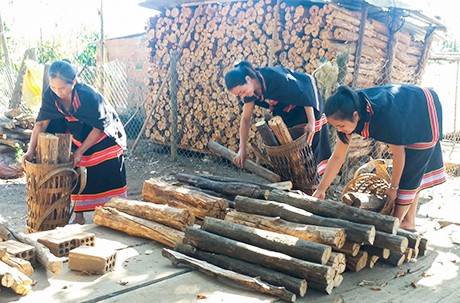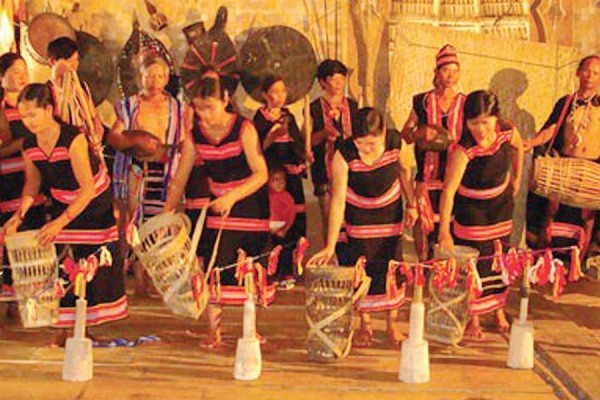(VOVWORLD) - Welcome to VOV’s Sunday Show, our biggest feature of the week, delving into the Vietnamese cultural landscape. I’m Kim Chi, your host. On today’s show, we’ll visit the Central Highlands to learn about the role of firewood in Gie Trieng’s marriage customs and the Et Rok wedding ceremony of the Bahnar.
 Wood is considered a treasured symbol of love by Gie Trieng women (Photo: baokontum.com) Wood is considered a treasured symbol of love by Gie Trieng women (Photo: baokontum.com) |
There are numerous things associated with love including a heart shape, a wedding ring, and a rose. However, none of them is as important as wood for young Gie Trieng women when it comes to love. Follow VOV’s correspondent in the Central Highlands to learn more about why wood is considered a treasured symbol of love by Gie Trieng women.
Passing by Ngoc Hoi and Dak Glei districts of Kon Tum province while travelling on the Ho Chi Minh Highway, you may notice woodpiles stacked neatly in walls next to local people’s stilt houses. All of the wood belongs to the daughters of those families. One can tell the number of young women of age for marriage in a household by counting the number of woodpiles in these two villages.
On their wedding day, they can lack money or gold but wood is a must for the brides. Dak Glei district’s village elder A Chon said wood is the dowry, and a treasured symbol of love. He said: “It’s very cold living in the forest. We need the heat from fire to survive. Therefore, wood is very important to us.”
Local women used to cut down the beech trees before the regulation on protecting the forest was established. While the wood is tough, it has straight grain so it is not only convenient to chop, but the wood also burns for a long time. When Gie Trieng women enter the age for marriage, it is time for them to take the wood from the forest. It takes them a long time and much effort. 24-year-old Y Nho said: “Gie Trieng women start to chop down the trees at the age of 15. Each must have 400 to 500 bundles of firewood to show off their skill and determination. The more firewood one has, the healthier and more hardworking she is considered.”
Collecting the wood can take months or years. Men can tell how strong, industrious, and skillful the women are by observing how big the stacks are and how even the wood is chopped. They will make their martial decisions based on that. Married for many years, A Kham from Ngọc Hồi district still remembered that his bride and her friend piggybacked 100 bundles of firewood to his house on their wedding day. He said: “I am very proud of my wife for having such huge bundles of firewood, which shows that she is healthy and hardworking.”
Local people’s lives no longer depend largely on wood. They have blankets and insulated mattresses for freezing nights. Gas and electric stoves are used widely but the custom of using wood as a dowry remains. Many women have switched to planted litsea trees after selling their bark, instead of natural beech trees in accordance with forest protection regulations. Y Chau from Ngoc Hoi district is one of the pioneers of this practice. She said: “We use litsea wood so that we don’t have to cut down the natural trees in the forest. It’s more convenient. We can also help improve the family’s income by doing so.”
The presented wood is also the symbol of piety as the brides don’t only present it to the groom but also her family-in-law on their wedding day. It is considered a valuable dowry that the groom’s family only use on special occasions.
You’re listening to VOV’s Sunday Show, our biggest show of the week. Still to come on the show, we’ll introduce the Et rok wedding ceremony of the Bahnar, another ethnic group living in the Central Highlands. Now, let’s enjoy a song call ‘Come to the plateau’.
 The Et Rok wedding ceremony (Photo: baomoi.com) The Et Rok wedding ceremony (Photo: baomoi.com) |
This is VOV’s Sunday Show. Our next destination is Kon Tum province, where the Bahnar live . In recent years, many Bahnar there have held the Et rok wedding ceremony. In this simple and inexpensive wedding ceremony, the bride and groom are blessed by numerous relatives.
Unlike other ethnic groups in the Central Highlands, the Bahnar do not request a dowry or wedding presents from the bride or groom. The cost for an Et rok wedding varies based on families’ finances but it requires only wine, chicken, and pork. The wedding is held at the house of the groom or bride.
At least 5 jars wine must be prepared for the parents and parents-in-law, the bride and the groom, village elders, the youngsters, and the guests. The host can use one or two pigs to treat the guests. Wealthy families can make dishes from buffalo or cow for the wedding ceremony. If both the bride and groom’s families can not afford it, their relatives and the community will help them.
Residing in Plei Don village, Kon Tum province, Puk said that during the wedding party, the groom and the bride go first. The groom is followed by his brothers while the bride is followed by her sisters. The couple are also accompanied by the parents and parents-in-law. The guests will make a toast and present gifts to the couple. Ms. Puk said: “The et rok wedding ceremony has been held for a long time. In the past, the guests needed to bring a jar of wine or a chicken to the wedding if they were third-degree relatives. The closer relatives must have a pig as a gift for the couples. But now, it has become much simpler. A bottle of wine, boiled eggs, or some candies can also be the gifts.
The Bahnar do not have a last name. The Et rok wedding is a chance for relatives to reunite and avoid inbreeding. Ms. Mari in Plei Don village said: “Relatives living far from each other may meet on several occasions without knowing that they are relatives. Attending the Et rok wedding helps them know their relations. The custom has been passed down through many generations to avoid inbreeding.”
Being a cultural researcher, Mr. A Jar in Plei Don village said the Et rok wedding ceremony used to be popular only in villages nestled in the Western region of Kon Tum city. Nowadays, many Bahnar in eastern Kon Tun city have started the practice, too. A Jar said: “The Et rok wedding ceremony lives up until now because it doesn’t cost too much, and is suitable with the living standard of the Bahnar. It’s also a chance for relatives to reunite. I hope that more and more people will decide to hold an Et rok wedding.”